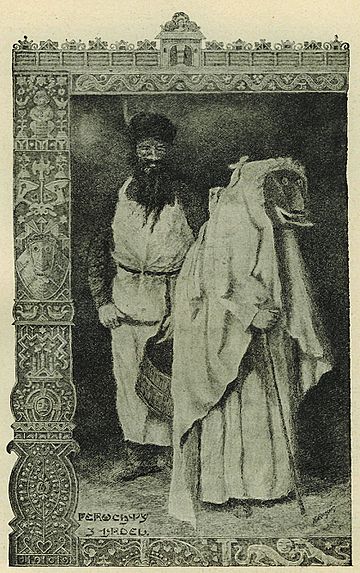Perchta facts for kids

Perchta (also known as Berchta) was a powerful spirit or goddess in ancient traditions from the Alps mountains. Her name might mean "the bright one." It comes from an old German word, beraht, which means "bright." Some people think her name is linked to the holiday of Epiphany. Another idea is that her name comes from an old German word meaning "hidden."
Perchta is often seen as similar to another Germanic goddess named Holda. They are like cousins in folklore. Both are believed to be guardians of animals. They also appear during the Twelve Days of Christmas. During this time, they watch over people who are spinning thread.
According to old stories, Perchta was known in the southern German and Austrian Alps. This includes places like Swabia, Alsace, Switzerland, Bavaria, and Austria. Some experts believe Perchta's stories grew from a mix of old Germanic and Celtic traditions after the Migration Period in the early Middle Ages.
Contents
Many Names for Perchta
Perchta had many different names. These names changed depending on the time and place. Some of her main names were Perahta and Berchte. Other names included Berchta and Frau Perchta.
In some areas, like Baden, Swabia, Switzerland, and parts of Slovenia, she was called Frau Faste. This means "the lady of the Ember days" (special fasting days). She was also known as Pehta or Kvaternica in Slovenia. Other names were Posterli, Quatemberca, and Fronfastenweiber.
In southern Austria, especially in Carinthia, there was a male version of Perchta. He was called Quantembermann in German or Kvaternik in Slovene. Another male figure, Berchtold, is also thought to be similar to Perchta.
Some other regional names for Perchta include Berigl, Berchtlmuada, Perhta-Baba, Zlobna Pehta, Bechtrababa, Sampa, Stampa, Lutzl, Zamperin, Pudelfrau, Zampermuatta, and Rauweib.
What Perchta Looked Like
In some stories, Perchta could change her appearance. She might look like a beautiful woman, as white as snow. Or, she might appear as an old, tired woman with a wrinkled face.
Many old descriptions say Perchta had one large foot. Sometimes it was called a goose foot or a swan foot. Some people believed this special foot showed that she was a magical being. It also linked her to spinning, as the foot might represent the foot that worked a spinning wheel.
In the Tyrol region, she was described as a small old woman. She had a very wrinkled face, bright, lively eyes, and a long, hooked nose. Her hair was messy, and her clothes were old and torn.
Traditional Stories About Perchta
Long ago, Perchta was known for making sure people followed rules. For example, she made sure people did not spin thread on holidays.
In the folklore of Bavaria and Austria, Perchta was said to travel through the countryside in midwinter. She would visit homes during the twelve days between Christmas and Epiphany. She especially liked to visit on Twelfth Night.
Perchta would know if the children and servants in a home had been good and worked hard. If they had, they might find a small silver coin the next day. The coin would be in a shoe or a bucket.
In the past, some people would leave food and drinks for Perchta and her helpers. They hoped to receive good luck and wealth in return. However, church leaders in the 1400s did not approve of this practice.
Later, church documents sometimes linked Perchta to other powerful female spirits. These included Holda, Diana, and Herodias.
Perchta's Companions
The word Perchten is the plural form of Perchta. This word now refers to her group of companions. It also names the animal masks worn in parades and festivals in the mountains of Austria.
In the 16th century, the Perchten took two forms:
- Schönperchten ("beautiful Perchten"): These were bright and lovely. They appeared during the Twelve Nights and festivals. They were believed to bring good luck and wealth to people.
- Schiachperchten ("ugly Perchten"): These had fangs, tusks, and horse tails. They were used to scare away demons and ghosts. Men would dress as ugly Perchten in the 16th century. They would go from house to house to drive away bad spirits.
Sometimes, the devil was seen as the ugliest Percht. And Frau Perchta was seen as the most beautiful Percht.
Perchta in Modern Times
Today, Perchta is often seen as someone who rewards generous people. She also punishes those who are bad, especially children who lie.
In Austria, especially in Salzburg, the Perchten are still a traditional part of holidays and festivals. For example, they are part of the Carnival Fastnacht. The wooden animal masks made for these festivals are still called Perchten.
In the Pongau region of Austria, large parades of Schönperchten (beautiful Perchten) and Schiachperchten (ugly Perchten) happen every winter. The beautiful masks are thought to bring good fortune. The ugly masks are worn to chase away evil spirits.
Other regional traditions include the Tresterer in the Pinzgau region. There are also stilt dancers in Unken. The Schnabelpercht (or "trunked Percht") is found in the Unterinntal region. And the Glöcklerlaufen ("bell-running") happens in the Salzkammergut. Many large ski resorts have turned these traditions into fun events for tourists every winter.
See also
- Baba Yaga
- Befana
- Frau Holle
- Krampus
- Oliebol
- Pre-Christian Alpine traditions
- Spillaholle
- Swabian-Alemannic-Fastnacht
- Weiße Frauen
- Wild Hunt
- In Spanish: Perchta para niños

